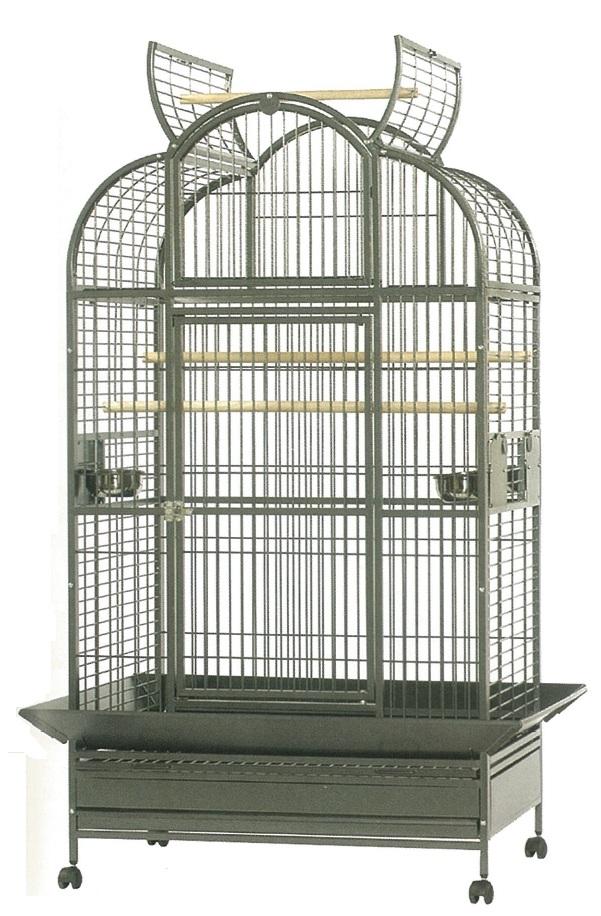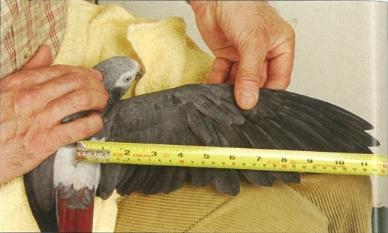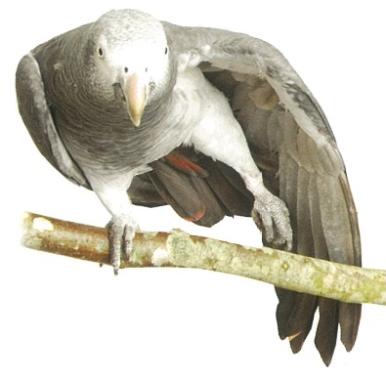While it is almost a given that a companion parrot will be kept in a cage, the amount of time your bird spends in a cage each day will have a great effect on its quality of life and behaviour. Greys need to spend many hours each day out of the cage, interacting with people and/or other birds just to remain mentally healthy. The cage should large enough so that the bird can easily flap its wings while it is inside. So the main factor in deciding on the minimum cage size for your bird is the bird's wingspan; this is the measurement from wing-tip to wing-tip of the bird's wings when they are fully outstretched, as though the bird were in flight. African greys have a wingspan of 71cm (28in); the Timneh's is slightly smaller at 61cm (24in). A cage where measurements in all three dimensions (height, depth and width) exceed the bird's wingspan will allow the bird to flap its wings. Sometimes it can be difficult to find a cage of these dimensions. However, so long as two of the measurements exceed this, and the third is, say, at least 61cm (24in), then the bird will be able to flap its wings. The width and depth of the cage are far more important considerations than its height since the bird will only use the top half of the cage anyway.
Cage construction
While the best and most expensive cages are made of stainless steel, most are made of mild steel which is then coated with various layers ofpaint. The paintwork is usually stove enamelled. This process hardens the paint and ensures it cannot be damaged or removed by the bird. The bars should be sufficiently thick and strong so that the bird cannot bend or damage them. Damaged bars can result in the protective coating being chipped away by the bird. Parrots enjoy being able to climb and this allows them some exercise. To aid this, the cage should have horizontal bars, as well as vertical ones. For the bird's safety, the spacing between the bars should be no more than 25mm (1 in); this prevents the bird from poking its head out between the bars. It is a good idea to choose a cage with the food pots mounted on swing-feeders which allows the food to be changed from outside the cage. The sliding tray in the base should be made of metal rather than plastic.
Cage construction
While the best and most expensive cages are made of stainless steel, most are made of mild steel which is then coated with various layers ofpaint. The paintwork is usually stove enamelled. This process hardens the paint and ensures it cannot be damaged or removed by the bird. The bars should be sufficiently thick and strong so that the bird cannot bend or damage them. Damaged bars can result in the protective coating being chipped away by the bird. Parrots enjoy being able to climb and this allows them some exercise. To aid this, the cage should have horizontal bars, as well as vertical ones. For the bird's safety, the spacing between the bars should be no more than 25mm (1 in); this prevents the bird from poking its head out between the bars. It is a good idea to choose a cage with the food pots mounted on swing-feeders which allows the food to be changed from outside the cage. The sliding tray in the base should be made of metal rather than plastic.
This cage is of sturdy construction and has four swing feeders. This side bars are mainly horizontal
which allows the bird to climb around easily. A flange near the base catches any spilt food.

To determine wingspan, measure the distance from the centre of the bird's back to the end of one outstretched wing, then double this figure.

Within the cage greys should be able to carry out most of their normal stretching and wing flapping actions, so ensure there is adequate space inside to allow this, while also leaving plenty of room for some hanging toys.

A triple swing-feeder fitted to the cage allows you to replenish the food bowls from outside the cage. This can be useful if you ask someone to care for your bird while you are out for the day.